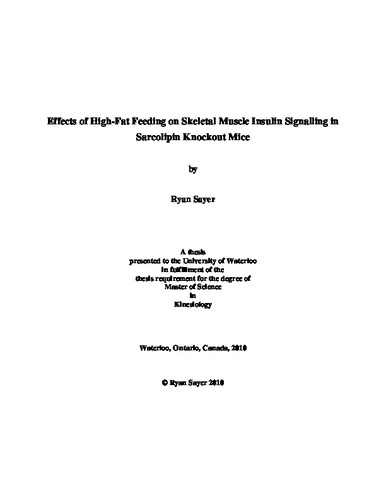| dc.description.abstract | Type II diabetes mellitus (T2DM) has been associated with the onset of diet-induced obesity, which is currently on the rise worldwide. T2DM is typically characterized by insulin resistance in peripheral tissues such as adipose tissue, liver, and skeletal muscle. In skeletal muscle it is widely accepted that the defective insulin action is due to the inability of the cell to sufficiently activate the insulin signalling pathway and promote systemic glucose uptake. The sarcolipin-null (KO) mouse is a potential novel model for diet-induced obesity and diabetes. KO mice become significantly more obese and display a greater glucose intolerance than wildtype (WT) mice following an 8-week high-fat diet (HFD; 42% calories from fat) but the underlying mechanisms are still unknown.
In this study the role of defective skeletal muscle insulin signalling in the development of the impaired glucose tolerance in KO mice was investigated. It was hypothesized that the HFD fed KO mice would exhibit greater reductions in IRS1 tyr628 and Akt ser473 phosphorylation (i.e. decreased activation of the insulin signalling pathway) than controls. Furthermore, it was believed that KO mice would display increased phosphorylation of IRS1 ser307, which is commonly associated with insulin resistance. At 16-weeks of age KO mice and littermates were subdivided into two groups and placed on either a HFD (n=30) or chow diet (n=24) for an 8-week period. Changes in body weight, glucose tolerance, and insulin tolerance were assessed pre- and post-diet period. Following the completion of the diet intervention mice were treated with an intraperitoneal injection of insulin (0.75U/kg) or vehicle solution and sacrificed for tissue collection. Epididymal/inguinal and retroperitoneal fat pads were removed for assessment of whole body adiposity. Whole gastrocnemius muscle was excised and homogenized for Western blot analysis of several key proteins of the insulin signalling cascade.
Following completion of the HFD KO mice (48.6 ± 1.6 g) weighed significantly more than HFD fed wildtype (WT) mice (41.5 ± 1.6 g), and all chow fed mice (KO: 36.8 ± 1.5 g; WT: 35.2 ± 1.2 g; p<0.001). Glucose tolerance testing showed that KO mice exhibited significantly greater glucose intolerance compared to control mice post-HFD (p<0.001). Insulin tolerance testing, however, revealed no change in insulin sensitivity in KO or WT mice post-HFD (p>0.05). The HFD fed KO mice (0.73 ± 0.06 g) had an elevated retroperitoneal fat pad weight than HFD fed WT (0.49 ± 0.05 g) and all chow fed mice (KO: 0.28 ± 0.04 g; WT: 0.24 ± 0.04 g; p<0.01). Western blot analysis revealed a similar reduction in insulin receptor substrate-1 (IRS1) tyr628 phosphorylation in both KO and WT mice following the HFD (Con WT: 2.82 ± 0.69; Con KO: 3.06 ± 0.73; HFD WT: 1.71 ± 0.28; HFD KO: 1.28 ± 0.11 fold increase over non-insulin stimulated mice; p<0.02). IRS1 ser307 phosphorylation was elevated in both genotypes post-HFD (HFD WT: 2.97 ± 1.19; HFD KO: 2.17 ± 0.59 fold increase over standard chow fed control mice; p<0.03). Insulin treatment did not stimulate phosphorylation of Akt ser473 in KO or WT mice regardless of diet (p>0.05). In summary there was no difference between KO and WT mice in skeletal muscle insulin sensitivity as assessed by the phosphorylation of insulin signalling intermediates. An increase in IRS1 ser307 phosphorylation appears to be the primary mechanism for the reduced activation of IRS1 following the HFD in both KO and WT mice. However, the results from the current investigation did not support the notion that impaired skeletal muscle insulin signalling is responsible for the more pronounced diet-induced glucose intolerance observed in KO mice. Future studies investigating the viability of skeletal muscle GLUT4 translocation and glucose uptake as well as the glucose-induced insulin secretion of pancreatic β-cells following consumption of a HFD would help elucidate the mechanism of glucose intolerance in KO mice. | en |

